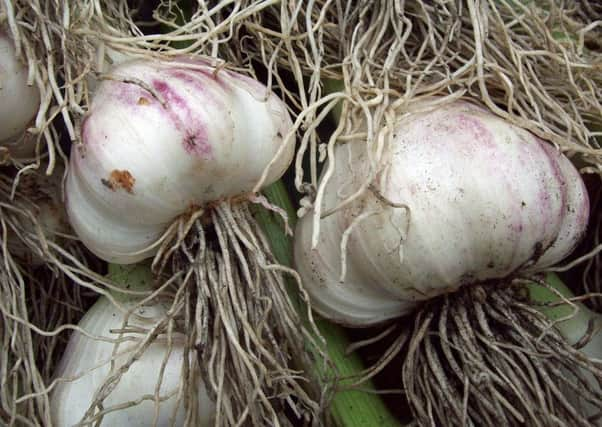GARDENING: Get your garlic dried out to last into winter
This article contains affiliate links. We may earn a small commission on items purchased through this article, but that does not affect our editorial judgement.


They should dry, but rust does affect the keeping qualities, so beware.
To dry garlic, brush off the majority of the muck and put them somewhere dry and warm – a greenhouse or conservatory is ideal.
Advertisement
Hide AdAdvertisement
Hide AdLay them out on a rack or staging where air can circulate, then just leave them to it. If you see any black patches developing, trim up the bulb and use them first.
After three-four weeks, the foliage should be off-white and quite dry and crispy.
If you can see any green left in the stems, or there’s a bit of “give” in them, leave them to dry a bit longer.
Then the fun begins - I’d strongly advise cleaning them off outside, because you’ll end up filthy.
Advertisement
Hide AdAdvertisement
Hide AdYou’ll need a wide bucket to catch the rubbish, scissors and an old toothbrush.
Trim the roots close to the bulb, but don’t damage the basal plate, or they won’t store well.
Strip off the papery outer layers until the bulb is clean, brush off dirt round the roots with the toothbrush and then trim the stem to the desired length.
I say “desired length” because some of you will want to plait them traditionally. I’m afraid I don’t do this, as I couldn’t even plait my daughter’s hair properly.
Advertisement
Hide AdAdvertisement
Hide AdAll I do is bunch about six bulbs together, all different lengths, so the bulbs are not touching, then tie the stems together tightly with twine. It’s not as pretty, but much faster and they taste just the same.
Then they are hung in the cellar where it’s dry and cool and usually last well into the new year.
JOBS FOR THE WEEKEND
Keep deadheading roses, perennials and annuals like sweet peas to keep the display going.
Temperatures are high at the moment and plants need a lot of water. Make sure you prioritise anything in containers, that’s newly-planted or greedy veg, like courgettes.
Advertisement
Hide AdAdvertisement
Hide AdCutting back plants in baskets followed by feeding can encourage new growth and help revive tired displays.
Plants with a carpet-like growth habit, e.g. some alpines, can become patchy, with central areas dying off. These patches can be in-filled with gritty compost, to encourage re-growth.
Some late-flowering border perennials may benefit from a quick-acting feed before they come into bloom, especially if the soil is not very fertile.
Start collecting seed from plants you want to grow next year, especially annuals such as Calendula, poppy and love-in-a-mist.
Advertisement
Hide AdAdvertisement
Hide AdTake semi-ripe cuttings of shrubs such as Choisya, Hydrangea and Philadelphus. Root them in pots of gritty compost in a cold frame or even with a plastic bag tied over them.
Clematis can be propagated by taking internodal cuttings (i.e. taking stem sections above and below a leaf, rather than cutting the stem immediately below a leaf joint).
Brown patches on conifers may indicate an earlier infestation by cypress aphids. Telltale signs include black sooty mould along the stems and shed skin cases. Spraying earlier in the summer may have helped, but once damage is done, conifers can take a long time to recover. Where hedges are affected, prune out brown shoots and tie in neighbouring branches to help fill the gaps.
Cuttings can be taken and grown on in the greenhouse. Fuschias and geraniums are good candidates.
Advertisement
Hide AdAdvertisement
Hide AdDon’t worry about brown patches on the lawn - they will recover quickly when the autumn rains arrive. If a completely green lawn is necessary, then use a sprinkler once a week. New areas of grass, sown or turfed in the spring, will need extra watering to keep them going through their first summer.
CONTACT
For more on these topics, plus cook what you grow, traditional recipes, North East information, environmental news and more, log on to www.mandycanudigit.co.uk (now smartphone friendly), www.sunderlandecho.com/gardening, follow me on Twitter @MandyCanUDigIt or you can like me on Facebook at Mandycanudigit